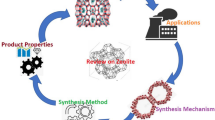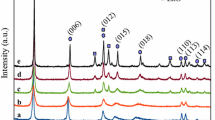Abstract
Azobenzene undergoes a unique reaction in the channels of H-ZSM5 zeolite at 593–673 K to give phenazine which is mainly retained within the zeolite. The yield of phenazine is increased by the addition to the reaction carrier gas of oxygen (1% vol.) which probably functions as a hydrogen acceptor. No reaction occurs when low acidity silicalite is used. On H-USY zeolite the yield of phenazine is low and the main product is a black, insoluble material which is probably polymeric. Benzo(c)cinnoline which is a known dehydrocyclization product from azobenzene under strongly acidic reaction conditions is never more than a trace product using H-ZSM5 or H-USY. A reaction scheme is proposed involving homolysis of the N ~ N bond in protonated trans-azobenzene, forming two radicals which, in a H-ZSM5 channel, are constrained in their mutual orientation so as to lead to the formation of phenazine.
Similar content being viewed by others

References
German Patent No. 513206 (1930). (to LG. Farbenindustrie; A. Wolfram, E. Hausdorfer, L. Schornig).
G.E. Lewis, Tetrahedron Lett. (9) (1960) 12.
H. Zollinger,Azo and Diazo Chemistry (Interscience, New York, 1961).
G.M. Badger, R.J. Drewer and G.E. Lewis, Aust. J. Chem. 16 (1963) 1042.
M. Guisnet, P. Magnoux and C. Canaff, In:Chemical Reactions in Organic and Inorganic Constrained Systems, ed. R. Setton (Reidel, Dordrecht, 1986) p. 131.
J.R. Anderson, Y.-F. Chang and R.J. Western, J. Catal. 118 (1989) 466.
N.Y. Chen, J.N. Miale and N.Y. Reagan, U.S. Patent No. 4,112,056 (1978).
J.R. Anderson, K. Foger, T. Mole, R.A. Rajadhyaksha and J.V. Sanders, J. Catal. 58 (1979) 114.
EPA/NIH Mass Spectral Data Base (1978).
H. Budzikiewicz, V. Kramer and H.-H. Perkampus, Z. Naturforsch. 25b (1970) 178.
S.V. Kessar and G.S. Joshi, Tetrahedron 29 (1973) 419.
A.T. Anderson and J. Klinowski, Nature 339 (1989) 200.
S.W. Benzon,Thermochemical Kinetics (Wiley, New York, 1976).
S.W. Benson et al., Chem. Rev. 69 (1969) 279.
J. Tjebbes, Acta Chem. Scand. 16 (1962) 916.
TRC Thermodynamic Tables (The Texas A and M University, College Station, U.S.A., 1986).
D.V. Banthorpe, In:Topics in Carbocyclic Chemistry, Vol. l, ed. D. Lloyd (Plenum Press, New York, 1969) p. 1.
R. Louw and J.W. Rothuizen, Tetrahedron Lett. 39 (1967) 3807.
H.H. Jaffé and R.W. Gardner, J. Amer.Chem. Soc. 80 (1958) 319.
Si-Jung Yeh and H.H. Jaffé, J. Amer. Chem. Soc. 81 (1959) 3279.
Author information
Authors and Affiliations
Rights and permissions
About this article
Cite this article
Anderson, J.R., Chang, Y.F. & Western, R.J. Formation of phenazine from azobenzene over H-ZSM5: Reaction control by a molecular constrained environment. Catal Lett 6, 59–66 (1990). https://doi.org/10.1007/BF00764053
Received:
Accepted:
Issue Date:
DOI: https://doi.org/10.1007/BF00764053



